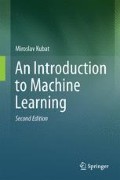Abstract
Two plants that look very much alike probably represent the same species; likewise, it is quite common that patients complaining of similar symptoms suffer from the same disease. In short, similar objects often belong to the same class—an observation that forms the basis of a popular approach to classification: when asked to determine the class of object x, find the training example most similar to it. Then label x with this example’s class.
Access this chapter
Tax calculation will be finalised at checkout
Purchases are for personal use only
Notes
- 1.
One benefit of these differences being squared, and thus guaranteed to be positive, is that this prevents negative differences, x i − y i < 0, to be subtracted from positive differences, x i − y i > 0.
- 2.
Among these, perhaps the best-known are the polar distance, the Minkowski metric, and the Mahalanobis distance.
- 3.
The optimal value of k (the one with the minimum error rate) is usually established experimentally.
- 4.
It is fair to mention that he used them for somewhat different purposes.
- 5.
References
Cover, T. M. (1968). Estimation by the nearest neighbor rule. IEEE Transactions on Information Theory, IT-14, 50–55.
Cover, T. M. & Hart, P. E. (1967). Nearest neighbor pattern classification. IEEE Transactions on Information Theory, IT-13, 21–27.
Dasarathy, B. V. (1991). Nearest-neighbor classification techniques. Los Alomitos: IEEE Computer Society Press.
Dudani, S. A. (1975). The distance-weighted k-nearest-neighbor rule. IEEE Transactions on Systems, Man, and Cybernetics, SMC-6, 325–327.
Fix, E. & Hodges, J. L. (1951). Discriminatory analysis, non-parametric discrimination. USAF School of Aviation Medicine, Randolph Field, TX, Project 21-49-004, Report 4, Contract AF41(128)-3
Hart, P. E. (1968). The condensed nearest neighbor rule. IEEE Transactions on Information Theory, IT-14, 515–516.
Tomek, I. (1976). Two modifications of CNN. IEEE Transactions on Systems, Man and Communications, SMC-6, 769–772.
Author information
Authors and Affiliations
Rights and permissions
Copyright information
© 2017 Springer International Publishing AG
About this chapter
Cite this chapter
Kubat, M. (2017). Similarities: Nearest-Neighbor Classifiers. In: An Introduction to Machine Learning. Springer, Cham. https://doi.org/10.1007/978-3-319-63913-0_3
Download citation
DOI: https://doi.org/10.1007/978-3-319-63913-0_3
Published:
Publisher Name: Springer, Cham
Print ISBN: 978-3-319-63912-3
Online ISBN: 978-3-319-63913-0
eBook Packages: Computer ScienceComputer Science (R0)

